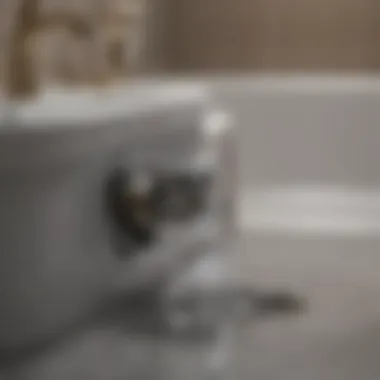Assessing Liquid Plumber for Toilet Clogs: Risks and Insights


Intro
When it comes to residential plumbing issues, toilet clogs rank among the most common frustrations for homeowners. Identifying effective solutions for such complications is essential for maintaining household comfort. One option that often comes up in discussions about unclogging toilets is Liquid Plumber. However, is this product really suitable for toilet use? This article takes a detailed look at the effectiveness and safety of using Liquid Plumber in toilets, while also considering the risks and alternatives.
Understanding Toilet Clogs
The causes of toilet clogs range from minor issues to more significant blockages. Some typical reasons include:
- Excessive toilet paper use: Using large amounts of toilet paper can lead to clogs.
- Foreign objects: Items not meant to be flushed can cause severe obstructions.
- Flushing wipes: Even products labeled as "flushable" can create problems.
Recognizing these causes helps homeowners address clogs effectively before escalating problems arise.
The Chemical Composition of Liquid Plumber
Liquid Plumber is a chemical drain cleaner primarily composed of sodium hydroxide. This compound is powerful in breaking down organic material, but it raises concerns regarding safety and plumbing compatibility. Understanding the chemical's nature is crucial when considering its application in sensitive systems like toilets.
Expert Recommendations
Experts generally caution against using Liquid Plumber for unclogging toilets. Most plumbing professionals suggest alternatives like:
- Plungers: A basic yet effective tool for many clogs.
- Drain snakes: Useful for unclogging pipes when plungers fail.
- Baking soda and vinegar: A natural alternative for minor clogs, offering a safer solution.
Safety Considerations
Using Liquid Plumber in toilets poses potential risks. The chemical can damage porcelain surfaces and lead to corrosion in pipes. Additionally, there are concerns about handling hazardous materials safely. Proper protective gear is important when using such cleaners. The implications of misuse extend beyond household damage; they can also pose health risks for inhabitants.
Important: Always read product labels for safety warnings and follow proper usage instructions.
The End
In summary, while Liquid Plumber may be an effective solution for certain types of clogs in sinks and drains, its use in toilets is fraught with risks. Considering safer, alternative methods is prudent for maintaining both plumbing integrity and household safety. This analysis encourages a thoughtful approach to common plumbing issues and promotes better practices in home maintenance.
Foreword to Toilet Clogs
Toilet clogs are a common issue in many households, often creating frustration and inconvenience. Understanding the mechanics of toilets and the primary causes for these blockages is essential. Not only does this knowledge help in managing minor issues, but it also guides homeowners in deciding when to use products like Liquid Plumber.
Clogs can lead to significant plumbing problems if addressed improperly. This necessitates a deeper awareness of how toilets function. Recognizing the various situations that can cause a clog gives homeowners a better chance of preventing them in the first place. The insights provided in this section will set the stage for evaluating Liquid Plumber and its suitability for unclogging toilets.
Understanding Toilet Mechanics
Toilets function through a system of gravity and pressure. When you flush, water is released from the tank into the bowl. This water pushes waste through the trap and into the plumbing system. The trap also serves an essential role by keeping sewer gases from entering the home. Any disruption in this process can lead to clogs.
Several components come together to create this system:
- Flush Valve: Controls the release of water into the bowl.
- Flapper: Seals the tank to prevent leaks.
- Overflow Tube: Protects against overflow.
Each part must work seamlessly. If one component fails, it can result in slow draining or complete blockages.
Common Causes of Clogs


Understanding typical clogs is crucial for effective management. Some leading causes include:
- Excessive Waste: Flushing too much toilet paper or non-dissolvable items can easily create a blockage.
- Tree Root Intrusion: Roots can invade sewer lines over time, leading to significant blockages.
- Aging Pipes: Older plumbing systems may have corrosion or buildup, making them prone to clogs.
- Foreign Objects: Items like toys or hygiene products can lead to immediate and severe blockages.
By knowing these factors, homeowners can take proactive steps to minimize the risk of clogs. Whether it's adjusting flushing habits or scheduling regular plumbing checks, awareness is key.
What is Liquid Plumber?
In this article, understanding Liquid Plumber is vital for several reasons. First, many people face toilet clogs, and Liquid Plumber is one of the most recognized solutions for this problem. It claims to effectively break down the materials causing blockages. Knowing the specifics of this product allows homeowners to assess whether it is a suitable choice for their plumbing issues. Furthermore, insights into its chemical makeup and intended uses can highlight both its advantages and limitations. This knowledge is essential for making informed decisions regarding toilet maintenance.
Chemical Composition
Liquid Plumber contains a combination of ingredients designed to dissolve clogs. The primary active ingredient is sodium hydroxide, also known as lye. This substance is highly alkaline, which enables it to react with organic materials such as hair, grease, and soap. This reaction breaks down the clog into smaller particles, ideally allowing them to clear through the pipes. In addition to sodium hydroxide, Liquid Plumber may also contain surfactants and other additives that enhance its cleaning capabilities.
While its chemical composition allows it to act quickly and effectively, it is important to recognize that these same chemicals can also be corrosive. Prolonged exposure to metal pipes can lead to deterioration, making this a significant consideration when evaluating its use for toilet clogs.
Intended Use Cases
Liquid Plumber is primarily marketed for household drains and sinks, especially those encountering slow drainage or complete blockages. Its intended use cases include:
- Bathroom sinks: Designed to clear away hair and soap residue.
- Kitchen sinks: Effective for grease buildup and food particles.
- Showers: Helps in breaking down hair clogs that accumulate in drains.
However, using Liquid Plumber in toilets is a matter of debate. Traditional plumbing wisdom suggests that the chemicals in Liquid Plumber are too harsh for the ceramic construction of toilets and the plumbing systems they connect to. The chemical reaction can create excessive heat, risking cracks and other damage to the toilet bowl and pipes.
Is Liquid Plumber Your Best Option?
Evaluating the effectiveness of Liquid Plumber for toilet clogs requires a detailed examination of its advantages and potential downsides. Many homeowners look towards chemical solutions when faced with plumbing issues, seeking quick fixes that require minimal effort. However, the implications of using such products should not be overlooked. Understanding whether Liquid Plumber is the optimal choice for unclogging toilets involves scrutinizing both its effectiveness and the associated risks.
Potential Risks Involved
When considering Liquid Plumber for toilet blockages, it is crucial to acknowledge the possible risks.
- Pipe Damage: Liquid Plumber contains powerful chemicals such as sodium hydroxide and potassium hydroxide. These substances can erode the inner lining of pipes over time, especially in older plumbing systems.
- Health Hazards: The fumes emitted from Liquid Plumber can be harmful. Inhaling these fumes can lead to respiratory issues, and skin contact may cause burns. Thus, handling the product with care is essential.
- Environmental Impact: Many chemical drain cleaners can be harmful to local water systems and aquatic life. Responsible disposal and minimal use are encouraged to reduce ecological harm.
It is advisable to consider these risks before deciding to use Liquid Plumber. Homeowners should weigh the potential consequences against the benefits of an immediate remedy.
Effectiveness on Toilet Clogs
The effectiveness of Liquid Plumber specifically on toilet clogs varies. Here are some considerations:
- Blockage Type: Liquid Plumber is often more effective on greasy or organic blockages rather than solid objects like toys or excessive toilet paper. For severe blockages, mechanical solutions might be more suitable.
- Time Required: Following the instructions correctly is vital. Depending on the type of clog, Liquid Plumber may require time to work. Sometimes, multiple applications are needed, which can be frustrating.
- Temporary Solution: Liquid Plumber may provide a quick fix, but it does not address underlying plumbing issues. Persistent clogging may indicate structural problems that need professional evaluation.
It's essential to remember that while Liquid Plumber may help in some situations, relying on it as a long-term solution can lead to further complications down the line.
Ultimately, while Liquid Plumber can offer a convenient approach for minor toilet clogs, its application should be carefully considered alongside alternative methods and the possible repercussions.
Alternatives to Liquid Plumber
In the realm of plumbing, the pursuit of effective solutions for toilet clogs transcends mere convenience; it delves into safety, sustainability, and long-term maintenance. While Liquid Plumber serves as a familiar choice for many, alternative methods warrant exploration. Employing these alternatives can result in both immediate relief from clogs and reduced risks associated with harsh chemicals. This section will detail practical and eco-friendly methods to tackle toilet obstructions.


Clogs can arise from various sources, and understanding the options available allows homeowners to make informed decisions. Below, we discuss two noteworthy alternatives that appeal to a diverse audience seeking viable solutions.
Plumbing Snake or Auger
A plumbing snake, often referred to as an auger, proves to be a straightforward yet effective tool for addressing stubborn toilet clogs. Unlike liquid drain cleaners, which may cause pipe damage or other hazards, a snake allows the user to physically remove blockages.
Using a plumbing snake involves the following steps:
- Insert the snake into the toilet drain opening.
- Turn the handle to feed the coil down the drain until resistance is felt.
- Rotate and push gently to break apart the clog.
- Withdraw the snake, which often brings the clog along with it.
This method is particularly beneficial because:
- No Chemicals: Avoids the risks associated with chemical drain cleaners.
- Cost-Effective: The one-time purchase of a snake can save costs on repeated chemical treatments.
- Actionable Results: Often provides immediate results, restoring function without causing further damage.
Natural Drain Cleaners
As awareness grows regarding environmental concerns, natural drain cleaners have emerged as a popular alternative to conventional chemical solutions. Products such as baking soda, vinegar, and even enzymatic cleaners can effectively tackle toilet clogs without harmful effects on pipes or the environment.
Here is a simple method using common household ingredients:
- Pour 1 cup of baking soda into the toilet bowl.
- Follow with a cup of vinegar.
- Let the mixture sit for at least 30 minutes to allow the reaction to break down organic matter.
- Flush the toilet to clear any remaining debris.
Natural drain cleaners are advantageous because:
- Eco-Friendly: Made from natural ingredients, reducing environmental impact.
- Easy and Safe: Safer to handle than chemical solutions; less risk of injury.
- Preventative: Regular use can help maintain clear drains and avoid future blockages.
In summary, considering alternatives to Liquid Plumber is crucial not only for effective clog removal but also for promoting a healthier plumbing system and environment. Methods like plumbing snakes and natural drain cleaners provide reliable solutions without subjecting your home to the potential hazards of harsh chemicals.
How to Unclog a Toilet Safely
Unclogging a toilet is a common household task that requires careful attention for both safety and effectiveness. Understanding how to approach this task ensures long-term plumbing health and avoids causing further complications. This section will elaborate on the importance of using proper techniques and tools, thereby minimizing damage to your plumbing. Employing safe practices promotes a better living environment and can save homeowners time and money in the long run.
Step-by-Step Guide
When dealing with a clogged toilet, a clear guideline is essential for effectively resolving the issue. Here are the steps you should follow:
- Assess the Situation: Before acting, check the water level in the toilet bowl. If it is too high, do not flush; this may cause overflow.
- Gather Tools and Materials: You will need a plunger, rubber gloves, and possibly a plumbing snake. If chemicals are considered, ensure they are safe for toilet use.
- Position the Plunger: Insert the plunger into the toilet bowl, ensuring it covers the drain completely. You want to create an airtight seal.
- Plunge Firmly: With the right technique, push down and pull up without breaking the seal, applying enough force to dislodge the clog. Repeat this motion several times if necessary.
- Flush the Toilet: Once the clog seems loose, flush the toilet once to see if water flows freely. If not, repeat the plunging process.
- Use a Plumbing Snake: If plunging does not clear the toilet, insert a plumbing snake into the drain. Rotate it to break up stubborn clogs.
- Final Check: After attempting to fix the clog, always check to see if your toilet is functioning as normal. If problems persist, it may be time to consider alternatives or professional help.
Remember, patience is the key. If you rush, it might lead to missteps that can damage your plumbing system further.
When to Call a Professional
There are times when the complexity of a clog exceeds the scope of standard DIY methods. Here are some situations that warrant calling in a professional:
- Repeated Clogs: If your toilet frequently clogs, this may indicate an underlying issue with your plumbing system.
- Severe Backup: An excessive amount of water or waste buildup that's unmanageable with standard tools suggests a more significant problem, possibly requiring specialized equipment.
- Persistent Odors: If foul smells persist despite efforts to unclog, this could signal a deeper issue like a sewage blockage.
- Disposal Issues: If your toilet won’t flush at all and there's no visible obstruction, professional assessment is crucial to avoid causing damage.
Opinions from Plumbing Experts
Understanding the views of plumbing experts is crucial for homeowners considering Liquid Plumber for toilet clogs. These professionals possess extensive experience and insight into plumbing systems, offering advice rooted in practical knowledge and industry standards. Experts help navigate the nuances of various drain cleaning methods, ensuring that the choices made are not only effective but also safe for plumbing systems. Their opinions can clarify when chemical solutions may prove counterproductive and when alternative methods could be more beneficial.


Industry Guidelines and Standards
Plumbing professionals often adhere to established guidelines and standards concerning drain cleaners. The American National Standards Institute (ANSI) offers recommendations regarding the use of chemical drain cleaners. It is vital to note that while some drain cleaners are safe for regular use, others, like Liquid Plumber, may have specific cautions due to their chemical composition.
- Chemical Safety: Many experts advise reading the labels and Material Safety Data Sheets (MSDS) before using any chemical. This ensures the user is aware of the potential hazards associated with its application.
- Compatibility with Plumbing Materials: Plumbers recommend checking if the chemical is compatible with the materials used in household plumbing, such as PVC or older metal pipes. Improper use can lead to corrosion, leaks, or even complete pipe failure.
- Environmental Regulations: Industry standards also typically include considerations for environmental impact. Many regions impose restrictions on the types of chemicals that can be legally used in residential settings, emphasizing the importance of eco-friendly alternatives.
Case Studies and Experiences
Case studies provide real-world examples of how Liquid Plumber has performed in practical situations. For instance, a plumbing company based in Chicago noted that Liquid Plumber can clear minor clogs effectively but poses risks for more severe blockages. In such instances, relying solely on the chemical can lead to more significant plumbing issues.
"In several cases we encountered, using Liquid Plumber resulted in a temporary fix. However, many homeowners ended up facing recurring problems as the underlying issues remained unresolved."
Another case from a plumbing professional in San Diego highlighted issues with older homes, where the use of Liquid Plumber led to pipe damage over time. This emphasizes the need for a thorough assessment before employing chemicals as a solution.
Collectively, these insights underscore the significance of expert opinions and guidelines when contemplating the use of Liquid Plumber. Homeowners are encouraged to consider these professional insights critically and to balance the immediate relief from clogs with the long-term health of their plumbing systems.
Long-term Effects of Chemical Drain Cleaners
The discussion of long-term effects of chemical drain cleaners is vital when evaluating the use of products like Liquid Plumber. Homeowners often prioritize quick solutions to plumbing problems without fully understanding the potential consequences. Awareness of these effects can lead to more informed choices and sustainable plumbing practices. Chemical cleaners can be effective in the short term, but their usage may lead to significant issues down the line.
Impact on Pipes
Chemical drain cleaners contain strong substances, which can effectively dissolve clogs. However, repeated or excessive use can have detrimental effects on plumbing systems. The harsh chemicals can corrode pipes over time, particularly if they are made from older materials such as galvanized steel or certain plastics. The risks of damage include:
- Deterioration: Pipe material may thin and weaken, leading to leaks.
- Joint Issues: Connections between pipes can loosen or fail, increasing the likelihood of water damage.
- Reduced Lifespan: Regular exposure to caustic substances may necessitate earlier pipe replacement.
It is essential for homeowners to monitor their plumbing health and consider whether the temporary benefit of using these drain cleaners outweighs the long-term risks associated with their chemical composition.
Environmental Considerations
Understanding the environmental impact of chemical drain cleaners is crucial. When these products enter the water system, they can contribute to pollution. The chemicals can harm aquatic life and disrupt ecosystems. Common issues include:
- Water Contamination: Residual chemicals may leach into groundwater or surface water.
- Toxicity to Wildlife: Fish and other organisms may be negatively affected, causing imbalances in the ecosystem.
- Long-term Soil Impact: Chemical residues can affect soil quality and biodiversity.
Many cities are encouraging alternatives that are less harmful to both plumbing and the environment. Making informed decisions can contribute not only to better plumbing health but also to preserving the environment and our water resources.
Culmination
Understanding the implications of using Liquid Plumber for toilet clogs is essential. This article has laid out clear evidence regarding its effectiveness and safety. The discussion revolves around various elements like the chemical makeup of Liquid Plumber and its suitability for toilet usage. Moreover, insights from plumbing professionals highlight best practices in drain maintenance.
Liquid Plumber is one option among many for addressing clogged toilets. It is crucial to evaluate not only its potential effectiveness but also the risks associated with its use. The effects on plumbing systems and the environment must not be overlooked, as these factors are paramount for responsible property management.
In summary, a well-rounded assessment enables homeowners to make informed decisions regarding their plumbing solutions and maintenance practices. It is not just about unclogging a toilet; it involves understanding the long-term consequences of using chemical drain cleaners. Therefore, this conclusion serves as a reminder to weigh options carefully before proceeding with any drain-clearing methods.
Summary of Key Points
- Liquid Plumber can alleviate clogged toilets, but it is not always the best choice.
- Risks include damage to pipes and potential environmental impacts.
- Alternatives exist that may provide safer, more efficient solutions for toilet clogs.
- Expert recommendations underpin the importance of following best practices in plumbing maintenance.
- Understanding the chemical composition of drain cleaners enriches homeowner knowledge.
Recommendations for Homeowners
- Explore multiple methods for unclogging toilets, such as plumbing snakes and natural cleaners.
- Before using Liquid Plumber, consider the specific circumstances of the clog.
- If a clog persists, do not hesitate to consult a plumbing professional for specialized assistance.
- Regular maintenance can prevent many clogs, emphasizing the importance of preventive measures.
- Stay informed about the products used in household maintenance, ensuring they align with environmental standards.
"Prevention is often more cost-effective than emergency fixes."
This encapsulation of insights and recommendations aims to equip homeowners with the necessary tools to manage plumbing issues responsibly and effectively.







